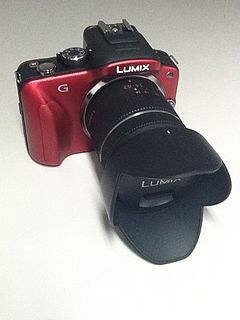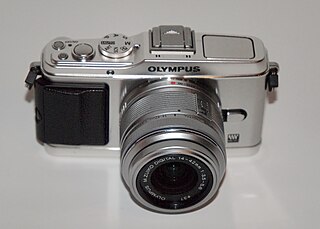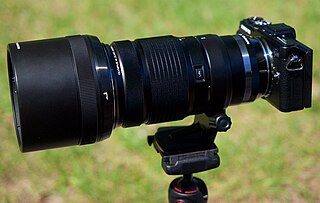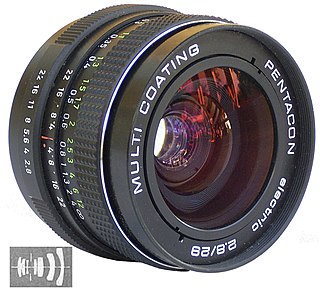
The Four Thirds System is a standard created by Olympus and Eastman Kodak for digital single-lens reflex camera (DSLR) and mirrorless camera design and development.

Macro photography, is extreme close-up photography, usually of very small subjects and living organisms like insects, in which the size of the subject in the photograph is greater than life size . By the original definition, a macro photograph is one in which the size of the subject on the negative or image sensor is life size or greater. However, in some uses it refers to a finished photograph of a subject at greater than life size.

The Micro Four Thirds system is a standard released by Olympus and Panasonic in 2008, for the design and development of mirrorless interchangeable lens digital cameras, camcorders and lenses. Camera bodies are available from Blackmagic, DJI, JVC, Kodak, Olympus, Panasonic, Sharp Corporation, and Xiaomi. MFT lenses are produced by Cosina Voigtländer, DJI, Kowa, Kodak, Mitakon, Olympus, Panasonic, Samyang, Sharp Corporation, Sigma, SLR Magic, Tamron, Tokina, Veydra, and Xiaomi, amongst others.

The Olympus Pen E-P1 announced on 16 June 2009 is Olympus Corporation's first camera that adheres to the Micro Four Thirds (MFT) system design standard. The first camera to use the Micro Four Thirds mount was Panasonic's G-1 camera.
The M.Zuiko Digital 17 mm f/2.8 is a wide-angle, pancake-style prime lens by Olympus Corporation, for the Micro Four Thirds System. It is sold in a kit with the Olympus PEN E-P1 camera body and available separately.

The Panasonic Lumix DMC-G3 is a digital mirrorless interchangeable lens camera adhering to the joint Olympus and Panasonic Micro Four Thirds System (MFT) system design standard. The Panasonic Lumix DMC-G3 is the eighth Panasonic MFT camera introduced under the standard and the thirteenth model MFT camera introduced by either Olympus or Panasonic, as of the G3 product announcement date.

The Panasonic Lumix G 14mmf/2.5 lens is a pancake-style prime lens for Micro Four Thirds system cameras. In the Micro Four Thirds format, it is moderately wide. As of its late-2010 release, it is claimed by Panasonic to be the lightest interchangeable digital-camera lens. It is the prime-lens option available with the Panasonic GF2 and GF3, and available separately.
The Olympus Corporation M.Zuiko Digital ED 9–18mm f/4-5.6 is a Micro Four Thirds System lens. In the Micro Four Thirds format, it is a zoom ranging from wide to ultra-wide. Like many other Olympus Micro Four Thirds zooms, the front lens elements extend for use, and retract for storage.

The Panasonic Leica DG Summilux 25mmf/1.4 lens is a normal lens for Micro Four Thirds system cameras. It is co-branded between Leica and Panasonic, built in Japan under Leica management.
The Olympus M.Zuiko Digital ED 12mm f/2 is a Micro Four Thirds System Prime lens by Olympus Corporation. In the Micro Four Thirds format, it is a wide- or ultra-wide lens.

The Panasonic Lumix DMC-G2 is a digital mirrorless interchangeable lens camera adhering to the Olympus and Panasonic developed Micro Four Thirds System (MFT) system design standard.

The Olympus PEN E-P3 announced on 30 June 2011 is Olympus Corporation's seventh camera that adheres to the Micro Four Thirds (MFT) system design standard. The E-P3 succeeds the Olympus PEN E-P2, and was announced in concert with two other models, the Olympus PEN E-PL3, and the Olympus PEN E-PM1.

Panasonic Lumix DMC-GF3 is the eighth camera in Panasonic's Lumix G-series adhering to the Micro Four Thirds System (MFT) design standard, and was announced in June, 2011.

The Zuiko Digital 25mm f/2.8 is a Four Thirds System standard-series lens manufactured by Olympus, sold both separately and bundled in a kit with the E-420 camera.
The Panasonic Lumix G X Vario PZ 45-175mm lensf/4.0-5.6 lens is a zoom lens for Micro Four Thirds system cameras. In the Micro Four Thirds format, it is moderately to long telephoto.
Zuiko is a brand of optical lenses made by Olympus Corporation that was used up to and including the Four Thirds system era. At the inception of the Micro Four Thirds system, new lenses for that system started to be branded as M.Zuiko Digital.

The Olympus Zuiko Digital 11-22mm 1:2.8-3.5 is an interchangeable wide angle zoom lens for the Four Thirds system. It was announced by Olympus Corporation on June 24, 2003.

The M.Zuiko Digital ED 40-150mm f/2.8 PRO is a Micro Four Thirds System lens by Olympus Corporation, sold as a standalone item. It is the first superzoom lens in the Olympus PRO range, which are constant-aperture, weather-sealed, metal-bodied lenses intended to accompany the higher end weather sealed OMD bodies such as the EM-1. It features an integrated lens function button, an integrated tripod mount, and an integrated removable lens hood.
Olympus M.Zuiko Digital ED 8 mm f/1.8 Fisheye Pro is an optically corrected fisheye lens.

Olympus M.Zuiko Digital ED 300 mm f/4 IS Pro is an optically corrected telephoto lens. With its extreme focal length of 300 millimetres it is the refracting prime lens with the longest focal length of the Micro Four Thirds system.
















